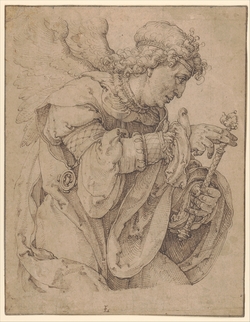
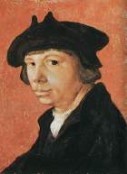
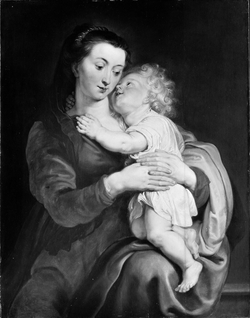
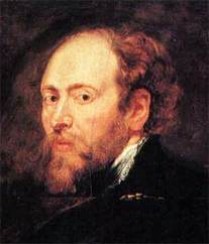
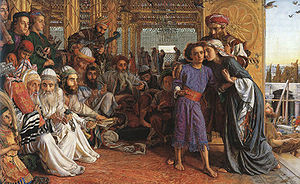

Jesus of Nazareth, who was also known as Jesus Christ, is the central figure of Christianity, which views him as the Messiah foretold in the Old Testament, with most Christian denominations believing him to be the Son of God who after his crucifixion, was raised from the dead. Islam considers Jesus a prophet and also the Messiah. Several other religions including Islam, Catholicism and Christianity revere him in some way. The son of a carpenter, Joseph and a mother known as the Virgin Mary, He is one of the most influential figures in history.
Our first painting (left to right), The Archangel Gabriel announcing the birth of Christ by Dutch painter Lucas Van Leyden (1494-1533) in pen and brown ink in black chalk depicts the angel paying reverence to the holy birth. The birth of Jesus according to scholars conclude that Jesus was born 7–2 BC/BCE and died 26–36 AD/CE. There is no contemporary evidence of the exact date of Jesus' birth. The common Gregorian calendar for numbering years, in which the current year is 2018, is based on an early medieval attempt to count the years from his birth. The Gospel of Matthew places his birth under the reign of Herod the Great, who died in 4 BC/BCE, and indications in the Gospel of Luke point to the same period, though Luke also describes the birth as taking place during the first census of the Roman provinces of Syria and Judaea, which is generally believed to have occurred in 6 AD/CE. Most scholars generally assume a date of birth between 6 and 4 BC/BCE. The earliest evidence of celebration on 25 December of the birth of Jesus is of the year 354 in Rome, and it was only later that the 25 December celebration was adopted in the East, with the exception of Armenia, where his birth is celebrated on 6 January. There is no month of the year to which scholars and authorities have not assigned his birth.
The second painting is the Virgin and the Child, Oil on wood by German painter Peter Paul Rubens (1577 - 1640, The MET) depicts Jesus and his mother, the Virgin Mary, In Christian and Islamic scriptures she is the mother of Jesus of Nazareth. Catholicism and some other Christian traditions honor her as a special saint, the "blessed virgin," who hears and acts upon prayers. Bible stories in the books of Matthew and Luke tell of the angel Gabriel announcing to Mary that the Holy Spirit will "overshadow" her and she will bear a holy child while still a virgin. Her fiancee, Joseph, decides at an angel's prompting not to break the engagement and marries the pregnant Mary. She gives birth to Jesus in a stable in Bethlehem, near Jerusalem. Mary follows Jesus during his adult ministry and is present at his crucifixion. The Acts of the Apostles lists her and Jesus' "brothers" among disciples who persevere after his death and resurrection, but whether these were Mary's own children is disputed. In Islam's holy book, the Koran, Mary's (Maryam's) story is in chapters 3 and 19. Allah, through an angel, declares Maryam "pure" and "exalted above all women," chosen to bear the prophet Jesus. She conceives simply by Allah's decree. In Christianity, Jesus is called the Son of God, divine as well as human. In Islam, he is human and decidedly not divine.
According to mainstream Christian doctrine Mary remained a virgin at least until Jesus was born. Most Protestants do not specifically claim that Mary remained a virgin after the birth of Jesus, but the Roman Catholic, Eastern Orthodox, Oriental Orthodox Churches, and many in the Anglican Church maintain that Mary also remained a virgin throughout the rest of her life. The New Testament recounts her presence at important stages during her son's adult life (e.g., at the Wedding at Cana and at his crucifixion). Also, she was present at communal prayers immediately after Jesus' Ascension. Narratives of her life are further elaborated in later Christian apocrypha, (or missing books of the bible), who give the names of her parents as Joachim and Anne. Christian churches teach various doctrines concerning Mary, and she is the subject of much veneration or respect. The area of Christian theology concerning her is known as Mariology. The conception of her Son Jesus is believed to have been an act of the Holy Spirit, and to fulfill the prophecy of Isaiah that a virgin would bear a son who would be called Emmanuel ("God with us"). The Roman Catholic Church, the Anglican Church, and the Eastern Catholic and Eastern Orthodox Churches venerate her as the Ever-Virgin Mother of God (Theotokos), who was specially favored by God's grace (Catholics hold that she was conceived without original sin) and who, when her earthly life had been completed, was assumed bodily into Heaven. Some Protestants, including certain Lutherans and Methodists, embrace veneration of Mary and also hold some of these doctrines. Others, especially in the Reformed tradition, question or even condemn the devotional and doctrinal position of Mary in the above traditions. Mary also holds a revered position in Islam. The Roman Catholic tradition has a well established philosophy for the study and veneration of the Virgin Mary via the field of Mariology with Pontifical schools such as the Marianum specifically devoted to this task.
The third painting, The Finding of the Savior in the Temple, by William Holman Hunt , (2 April 1827 – 7 September 1910. Hunt was an English painter, and one of the founders of the Pre-Raphaelite Brotherhood). The depiction of the painting is also called "Christ among the Doctors" or the Disputation (the usual names in art), and was an episode in the early life of Jesus. It is the only event of the later childhood of Jesus mentioned in a gospel. The episode is only described in Luke 2:42-51. Jesus at the age of twelve accompanies Mary and Joseph to Jerusalem on pilgrimage, following "the custom of the feast" (NKJV) - that is, Passover. On the day of their return, Jesus "lingered" in the Temple, but Mary and Joseph thought he had gone ahead of them. Mary and Joseph headed back home and after a day of travel realized Jesus was missing, so they returned to Jerusalem, finding Jesus three days later. He was found in the Temple in discussion with the elders who were amazed at his learning, especially given his young age. When admonished by Mary, Jesus replied "Why did you seek Me? Did you not know that I must be about My Father’s business". Here began the education of the young Jesus.